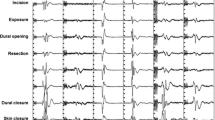Abstract
For the resection of anteriorly located meningiomas, various approaches have been used. Posterior approach is less invasive and demanding; however, it has been associated with increased risk of spinal cord injury. We evaluated ten consecutive patients that underwent surgery for spinal meningiomas. All patients were preoperative assessed by neurological examination, computed tomography and magnetic resonance imaging. All tumors were ventrally located and removed via a posterior approach. Transcranial motor-evoked potentials (TcMEPs), somatosensory-evoked potential (SSEP) and free running electromyography (EMG) were monitored intraoperative. Postoperative all patients had regular follow-up examinations. There were four males and six females. The mean age was 68.2 years (range 39–82 years). In nine out of ten cases, the tumor was located in the thoracic spine. A case of a lumbar meningioma was recorded. The most common presenting symptom was motor and sensory deficits and unsteady gait, whereas no patient presented with paraplegia. All meningiomas were operated using a microsurgical technique via a posterior approach. During the operation, free running EMG monitoring prompted a surgical alert in case of irritation, whereas TcMEP and SSEP amplitudes remained unchanged. Histopathology revealed the presence of typical (World Health Organisation grade I) meningiomas. The mean Ki-67/MIB-1 index was 2.75% (range 0.5–7). None of our patients sustained a transient or permanent motor deficit. After a mean follow-up period of 26 months (range 56–16 months), no tumor recurrence and no instability were found. Posterior approach for anteriorly located meningiomas is a safe procedure with the use of intraoperative monitoring, less invasive and well-tolerated especially in older patients. Complete tumor excision can be performed with satisfactory results.



Similar content being viewed by others
References
Albanese V, Platania N (2002) Spinal intradural extramedullary tumors. Personal experience. J Neurosurg Sci 46:18–24
Solero CL, Fornari M, Giombini S (1989) Spinal meningiomas: review of 174 operated cases. Neurosurgery 25:153–160
Cohen-Gadol AA, Zikel OM, Koch CA (2003) Spinal meningiomas in patients younger than 50 years of age: a 21-year experience. J Neurosurg (Spine) 98:258–263
Weil SM, Gewirtz RJ, Tew JM (1990) Concurrent intradural and extradural meningioma of the cervical spine. Neurosurgery 27:629–631
Messori A, Rychlicki F, Salvolini U (2002) Spinal epidural en-plaque meningioma with an unusual pattern of calcification in a 14-year-old girl: case report and review of the literature. Neuroradiology 44:256–260
Bruna J, Brell M, Ferrer I, Gimenez-Bonafe P (2007) Ki-67 proliferative index predicts clinical outcome in patients with atypical or anaplastic meningioma. Neuropathology 27:114–120
Roser F, Nakamura M, Bellinzona M (2006) Proliferation potential of spinal meningiomas. Eur Spine J 15:211–215
Gottfried ON, Gluf W, Quinones-Hinojosa A (2003) Spinal meningiomas: surgical management and outcome. Neurosurg Focus 14:e2
Gerszten PC, Burton SA, Ozhasoglu C (2008) Radiosurgery for benign intradural spinal tumors. Neurosurgery 62:887–895
Sacko O, Haegelen C, Mendes V (2009) Spinal meningioma surgery in elderly patients with paraplegia or severe paraparesis: a multicenter study. Neurosurgery 64:503–509
D’Aliberti G, Talamonti G, Villa F (2008) Anterior approach to thoracic and lumbar spine lesions: results in 145 consecutive cases. J Neurosurg Spine 9:466–482
Gambardella G, Gervasio O, Zaccone C (2003) Approaches and surgical results in the treatment of ventral thoracic meningiomas. Review of our experience with a postero-lateral combined transpedicular–transarticular approach. Acta Neurochir (Wien) 145:385–392
Giroux JC, Nohra C (1978) Anterior approach for removal of a cervical intradural tumor: case report and technical note. Neurosurgery 2:128–130
Steck JC, Dietze DD, Fessler RG (1994) Posterolateral approach to intradural extramedullary thoracic tumors. J Neurosurg 81:202–205
Holland NR (1998) Subcortical strokes from intracranial aneurysm surgery: implications for intraoperative neuromonitoring. J Clin Neurophysiol 15:439–446
Gezen F, Kahraman S, Canakci Z (2000) Review of 36 cases of spinal cord meningioma. Spine 25:727–731
Levy W, Bay J, Dohn D (1982) Spinal cord meningioma. J Neurosurg 57:804–812
Jho HD (1997) Endoscopic microscopic transpedicular thoracic discectomy. Technical note. J Neurosurg 87:125–129
Krieger D, Adams HP, Albert F (1992) Pure motor hemiparesis with stable somatosensory evoked potential monitoring during aneurysm surgery: case report. Neurosurgery 31:145–150
Mizoi K, Yoshimoto T (1993) Permissible temporary occlusion time in aneurysm surgery as evaluated by evoked potential monitoring. Neurosurgery 33:434–440
Welch WC, Rose RD, Balzer JR (1997) Evaluation with evoked and spontaneous electromyography during lumbar instrumentation: a prospective study. J Neurosurg 87:397–402
Voulgaris S, Karagiorgiadis D, Alexiou G, Mihos E, Zigouris A, Fotakopoulos G, Drosos D, Pahaturidis D (2010) The value of transcranial motor evoked potentials and electromyography monitoring in spinal stenosis surgery. J Clin Neurosci. doi:10.1016/j.jocn.2009.04.013
Sloan TB, Heyer EJ (2002) Anesthesia for intraoperative neurophysiologic monitoring of the spinal cord. J Clin Neurophysiol 19:430–443
Lo YL, Dan YF, Tan YE (2006) Intraoperative motor-evoked potential monitoring in scoliosis surgery: comparison of desflurane/nitrous oxide with propofol total intravenous anesthetic regimens. J Neurosurg Anesthesiol 18:211–214
Author information
Authors and Affiliations
Corresponding author
Rights and permissions
About this article
Cite this article
Voulgaris, S., Alexiou, G.A., Mihos, E. et al. Posterior approach to ventrally located spinal meningiomas. Eur Spine J 19, 1195–1199 (2010). https://doi.org/10.1007/s00586-010-1295-z
Received:
Revised:
Accepted:
Published:
Issue Date:
DOI: https://doi.org/10.1007/s00586-010-1295-z




